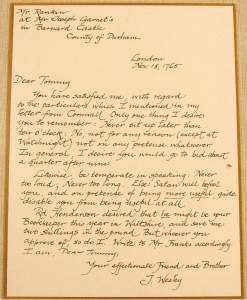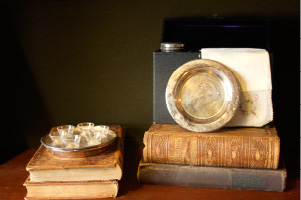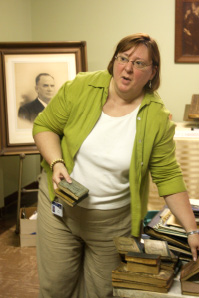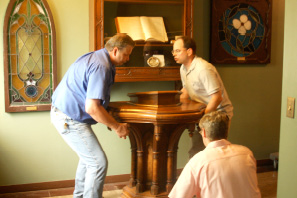
By Leslie Collins
Northeast News
August 10, 2011
Piece by piece, the history of the Melrose United Methodist Church is leaving its doors.
Congregation members no longer meet in the 123-year-old church in Northeast and church goers said their final farewells last month.
“It’s extremely painful,” said longtime member Sara Reed. “We’re unsure as to what’s going to happen to the building.”
Both start-up churches and charter schools have voiced interest in the church located at 200 N. Bales, Reed said, but nothing’s set in stone.
Due to a dwindling congregation and lack of finances, the church disbanded last month and Reed compared it to breaking up a close-knit family.
In the midst of the split, positives remain.
A number of items like communion sets, tables, chairs and cookware are being delivered to start-up churches and the Kansas City Museum received a few artifacts of its own, including a handwritten letter from John Wesley, Christian theologian and founder of the Methodist Episcopal Church. Other items being donated to the museum include artifacts once owned by Nathan Scarritt, who helped establish Westport High School and pastored and founded the Melrose United Methodist Church.
“Of course it’s very sad because we’re benefiting from the closing of this important cultural institution right down the street from us, but at the same time, it gives us the opportunity to honor Nathan and his family and the life of the neighborhood. We’re pleased to be able to help in that way,” said Christopher Leitch, historic house director of the Kansas City Museum.
Other significant items, Leitch said, include church bulletins, event programs, photo scrapbooks and other files related to the public, social and business life of the church, altar ware, commemorative dishes, Scarritt’s traveling communion kit and his original Bible, the original Gothic-style pulpit, two stained glass windows, handwritten baptismal records, among other items.
All of these materials aid in understanding the cultural history of the neighborhood, as well as a genealogical history, he said.
“They’re incredibly rich resources for the historical researcher,” he added.
Items that belonged to Scarritt are also valuable, he said.
“It’s really significant that his hands touched those things and carried them around. He saw so much trial, tribulation and adventure traveling around Indian Reservations (as a missionary) in the mid to late 19th Century. It couldn’t have been easy.”
Asked what the museum will do with the artifacts, Leitch said the items will be stored for now at Union Station and will be included in the Community Curator Series pamphlet. Eventually, the Kansas City Museum would like to exhibit some of the artifacts at the museum following the museum’s renovations, he said.
“These artifacts are historically relevant to not just Scarritt, but to this neighborhood,” Reed said. “We know the museum will be able to do something spectacular with them.”

Kansas City Museum employees sift through donations from Melrose United Methodist Church in Northeast and load the artifacts into their vehicles for storage at Union Station. Photos by Andrew Mouzin

















